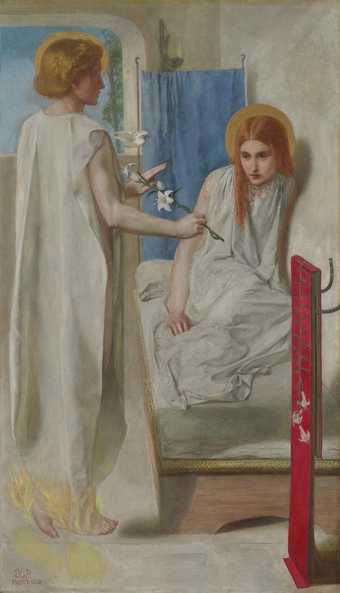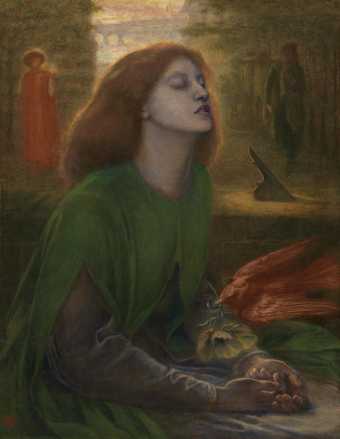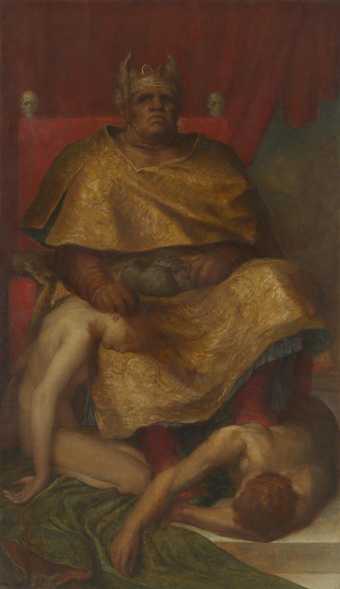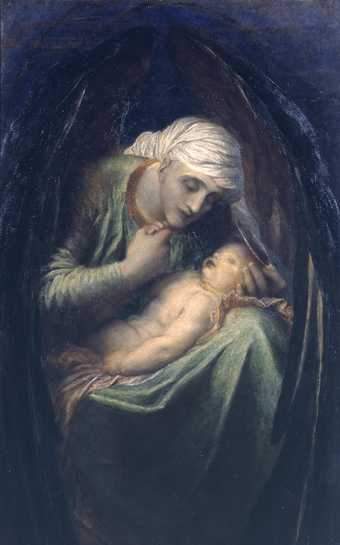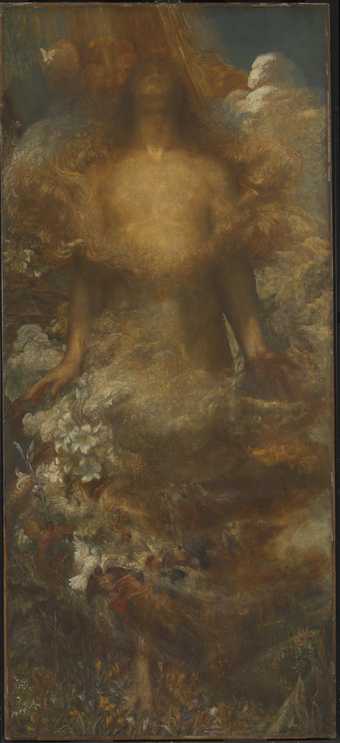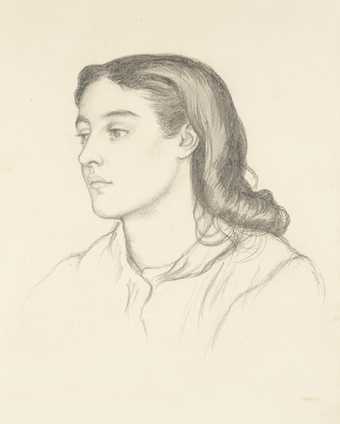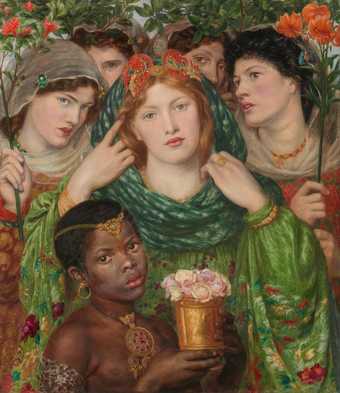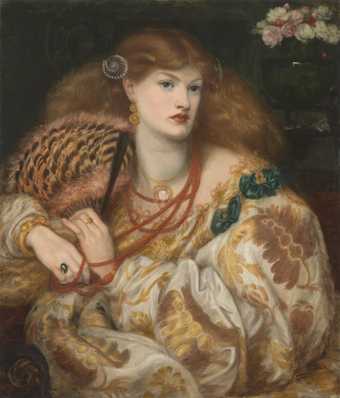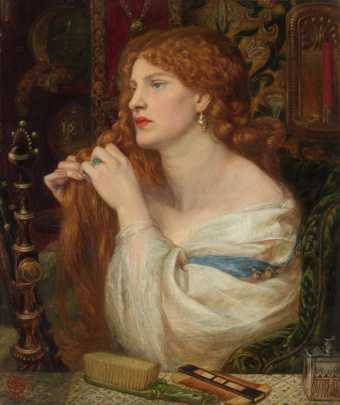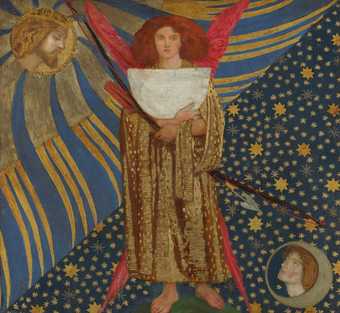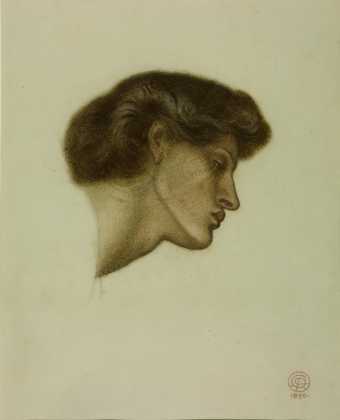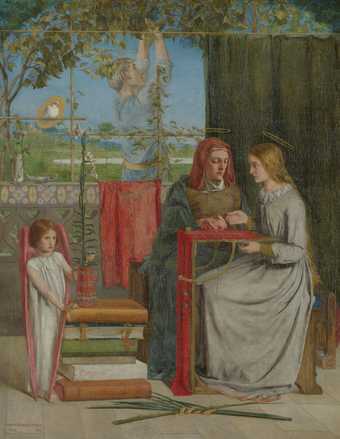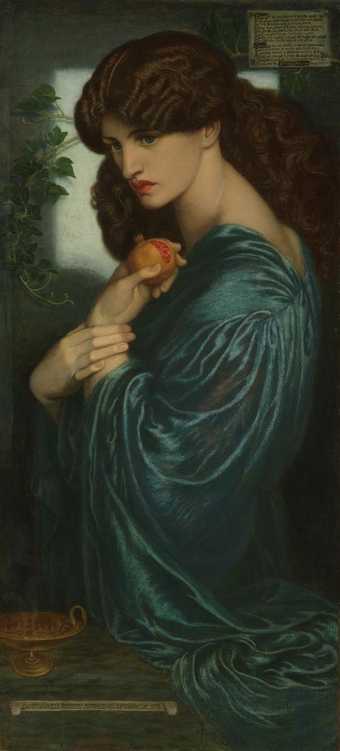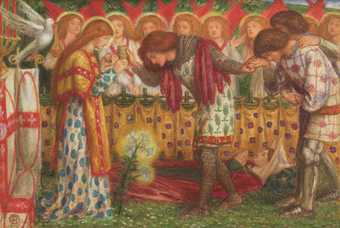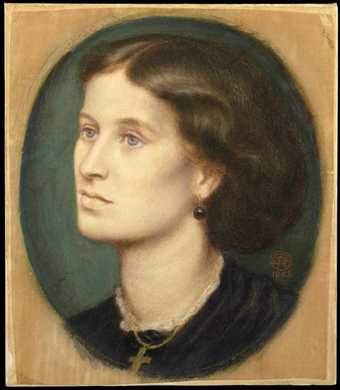
In Tate Britain
- Artist
- Dante Gabriel Rossetti 1828–1882
- Medium
- Oil paint on canvas
- Dimensions
- Support: 483 × 457 mm
frame: 819 × 801 × 88 mm - Collection
- Tate
- Acquisition
- Presented by Madame Deschamps in memory of Georgiana, Baroness Mount-Temple 1909
- Reference
- N02440
Summary
This is an early, unfinished version of Rossetti's The Blessed Damozel (1875-8, Fogg Art Museum, Harvard University). The picture was begun in September 1873, but, after working on the head, the artist soon abandoned it and had it cut down to its current size. The subject derives from one of Rossetti's own poems, first published in 1850 in The Germ:
The blessed damozel leaned out
From the gold bar of Heaven;
Her eyes were deeper than the depth
Of waters stilled at even;
She had three lilies in her hand,
And the stars in her hair were seven.
The poem expresses the longing felt by a dead woman for her lover, who is still alive. In the finished picture she looks down towards her beloved, who is depicted in the predella below. Behind her, pairs of lovers, united once again in heaven, embrace joyfully. The inspiration for Rossetti was clearly the premature death of his own wife, Lizzie Siddal, who died from an overdose of laudanum. Rossetti may also have been influenced in his choice of subject by the thoughts and writings of the Swedish theologian Emmanuel Swedenborg (1688-1772). In Conjugial Love (1768) Swedenburg wrote that each man or woman has an ideal partner - a 'conjugial' partner - and that their union constitutes an eternal, sanctified love. However, Rossetti did not use Lizzie's features for either Sancta Lilias or The Blessed Damozel. Instead, possibly at the suggestion of William Graham, who commissioned the work, he called upon the model Alexa Wilding. Even more significant, the women in the background of The Blessed Damozel were modelled on Jane Morris, perhaps denoting a dilemma in Rossetti's mind as to who his 'ideal partner' might be.
In Rossetti's poem, the Damozel has seven stars in her hair. This is an oblique reference to the seven daughters of Atlas and Pleione, who were transformed into the seven stars of the Pleiades. In the picture Rossetti has included only six stars, since one of the stars, Merope, ashamed of her love for Sisyphus, a mere mortal, shined invisibly. Rossetti, condemned to a meaningless and relentless existence without Lizzie, perhaps identifies with Sisyphus, who was forced to roll a giant boulder eternally uphill. In the poem and the finished picture the Damozel holds three lilies, referring both to the Holy Trinity and the Annunciation. In Sancta Lilias (Sacred Lily) Rossetti has substituted yellow irises, which belong to the lily family. In Classical myth Iris was the goddess of the rainbow, the bridge between heaven and earth. In the context of the picture, therefore, it may be intended to represent the link between Rossetti and Lizzie Siddal, between the earthly and the spiritual.
Further reading:
Virginia Surtees, The Paintings and Drawings of Dante Gabriel Rossetti (1828-1882): A Catalogue Raisonné, 2 vols., Oxford 1971, p.153, no.257, reproduced pl.198.
Andrew Wilton and Robert Upstone (eds), The Age of Rossetti, Burne-Jones & Watts: Symbolism in Britain 1860-1910, exhibition catalogue, Tate Gallery, London 1997, pp.191-3, reproduced p.192, in colour.
Frances Fowle
December 2000
Does this text contain inaccurate information or language that you feel we should improve or change? We would like to hear from you.
Display caption
This is the abandoned first version of one of Rossetti’s most important pictures, The Blessed Damozel (1875–8). He first treated the subject in a poem which, inspired by Dante’s love for Beatrice, describes a dead woman’s yearning for her still-living lover. In the completed painting, Rossetti shows the Damozel looking down on her beloved from Heaven; this is the scene shown here. Rossetti’s fascination with the separation imposed by death proved eerily prophetic when his wife Elizabeth Siddall died of an overdose of laudanum in 1862.
Gallery label, November 2016
Does this text contain inaccurate information or language that you feel we should improve or change? We would like to hear from you.
Explore
- emotions, concepts and ideas(16,416)
-
- emotions and human qualities(5,345)
- actions: postures and motions(9,111)
-
- looking down(200)
- woman(9,110)
- head / face(2,497)
- individuals: female(1,698)
- birth to death(1,472)
-
- death(685)
You might like
-
Dante Gabriel Rossetti Ecce Ancilla Domini! (The Annunciation)
1849–50 -
Dante Gabriel Rossetti Beata Beatrix
c.1864–70 -
George Frederic Watts Mammon
1884–5 -
George Frederic Watts Death Crowning Innocence
1886–7 -
George Frederic Watts ‘She shall be called woman’
c.1875–92 -
Dante Gabriel Rossetti Miss Robertson (Mrs Fernandez)
c.1866 -
Dante Gabriel Rossetti The Beloved (‘The Bride’)
1865–6 -
Dante Gabriel Rossetti Monna Vanna
1866 -
Dante Gabriel Rossetti Aurelia (Fazio’s Mistress)
1863–1873 -
Dante Gabriel Rossetti Dantis Amor
1860 -
Dante Gabriel Rossetti Study for the Head of Love, for ‘Dante’s Dream at the Time of the Death of Beatrice’
1870 -
Dante Gabriel Rossetti The Girlhood of Mary Virgin
1848–9 -
Dante Gabriel Rossetti Proserpine
1874 -
Dante Gabriel Rossetti Mrs Vernon Lushington
1865

